

Budweiser Clydesdales
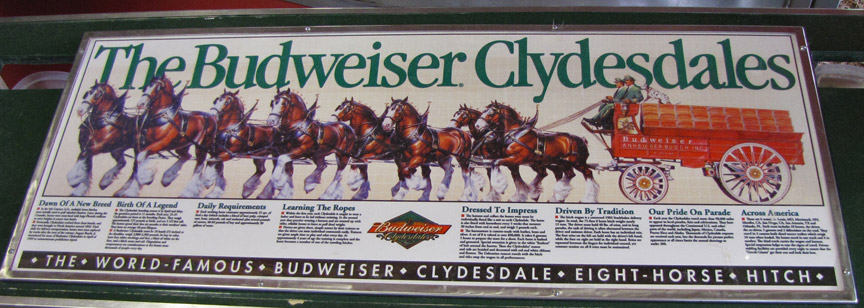
The Clydesdale is a breed of draft horse derived from the farm horses of Clydesdale, Scotland, and named after that region. Thought to be over 300 years old, the breed was extensively used for pulling heavy loads in rural, industrial and urban settings, their common use extending into the 1960s when they were still a familiar sight pulling the carts of milk and vegetable vendors.
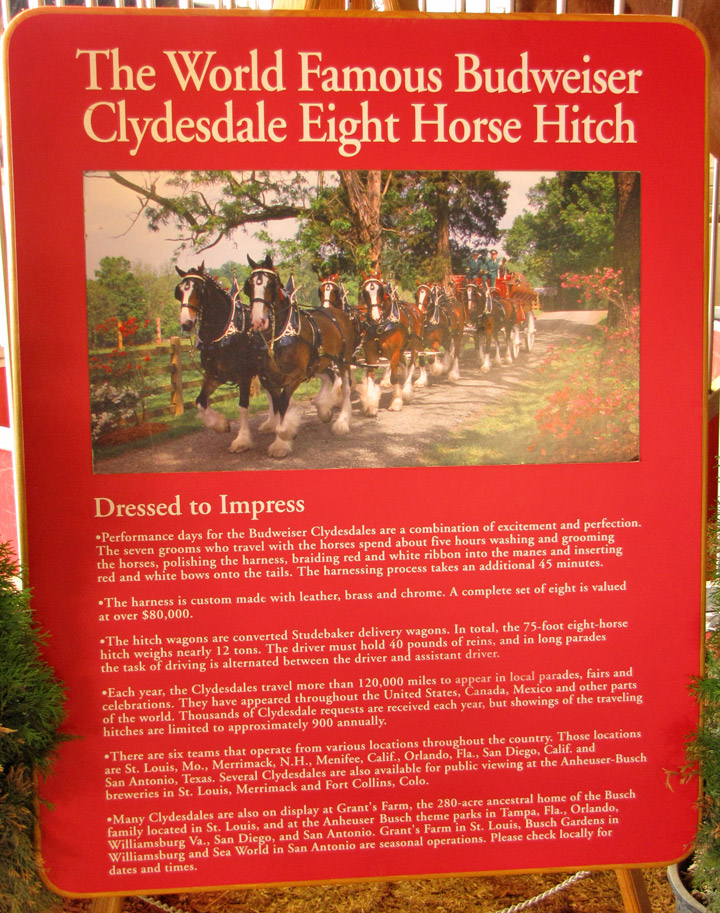
They have been exported in the Commonwealth and United States where they are
famous for their use as the mascot of various beer brands, including
Anheuser-Busch's Budweiser brand, Carlton & United Beverages and several others.

At one time there were at least 140,000 Clydesdales known in Scotland; by 1949
just 80 animals were licensed in England and by 1975 the Rare Breeds Survival
Trust had listed the breed as "vulnerable". Clydesdales have since seen
resurgence in popularity and population, resulting in the breed's status being
reclassified favorably as "at risk" with an estimated global population of just
5,000 individuals. Clydesdales are now most numerous in the United States where
recently over 600 foals are reportedly born each year.
Today, the Clydesdale's most significant presence is in exhibition and parades.
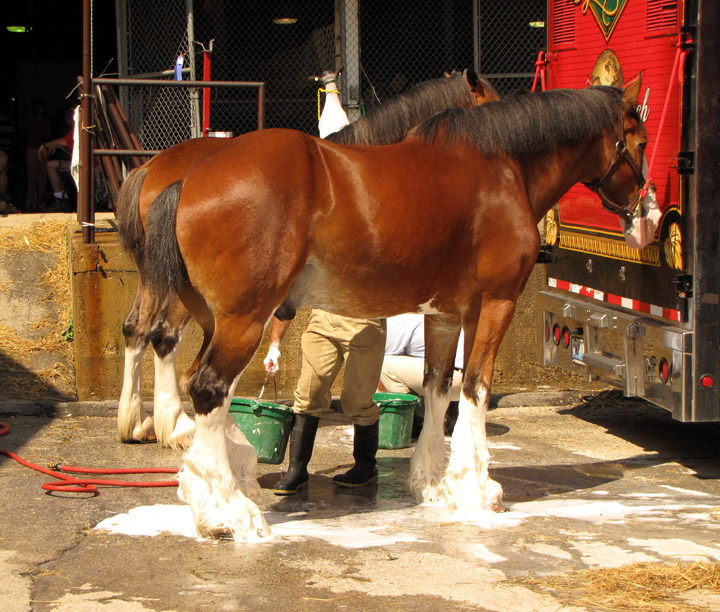
Clydesdales are noted for grace and versatility; they stand on average between
16 - 17 hands (the current world-record holding Clydesdale is 20 hands) in
height and can weigh upwards of one short ton (2,000 pounds). A Clydesdale has
an elegant head, with a straight profile, a convex profile is frowned upon,
small ears, large, dark eyes and a heavy forelock. The neck is long and slightly
arched, the chest deep, the shoulders are well sloped and muscular. The action
is energetic and ground covering. The Clydesdale tends to exhibit a longer
coupling than its cousin, the Shire and the withers are clearly defined. The
rump presents a well-muscled and distinctively rounded silhouette. The legs
should be long and strong with characteristically large hoof size, typically
being at least twice the diameter of those of a light riding horse, such as a
Thoroughbred. The pasterns are longer and sloping than those of a stock-type
horse. Perhaps the most widely recognized feature of the Clydesdale's appearance
is the abundance of feather, the long hairs that fall from just below the knees
and hocks to cover the hooves.
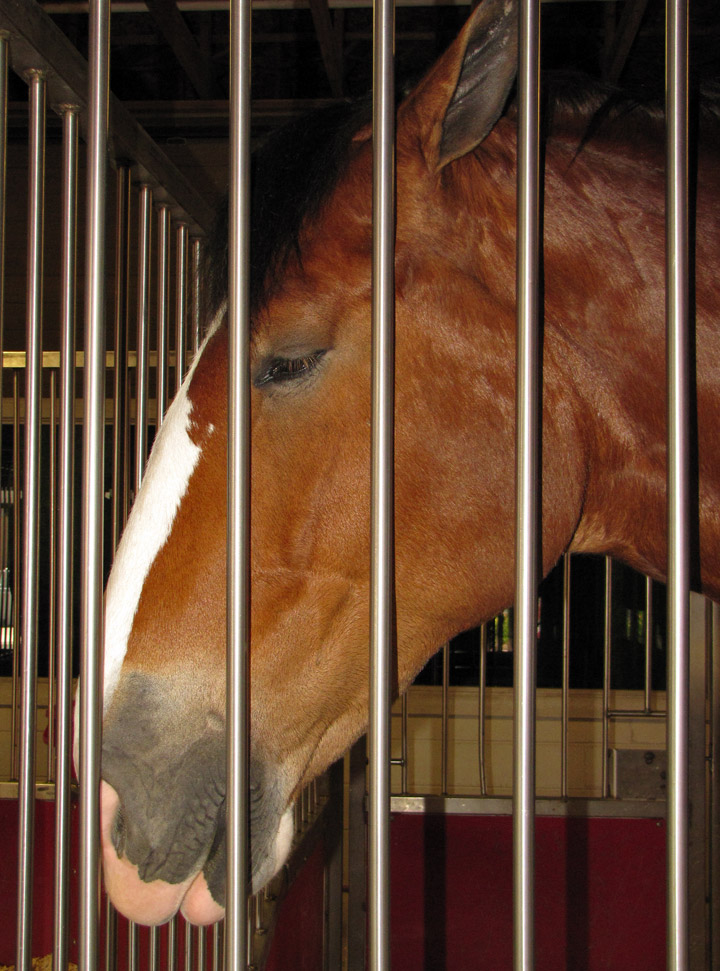
My Name is Chad

The characteristic action of a Clydesdale is demonstrated at a trot; an animated
gait with high hoof action in both the front and rear. Despite its large size,
the Clydesdale presents with an energetic quality described by the Clydesdale
Horse Society as "gaiety of carriage and outlook."
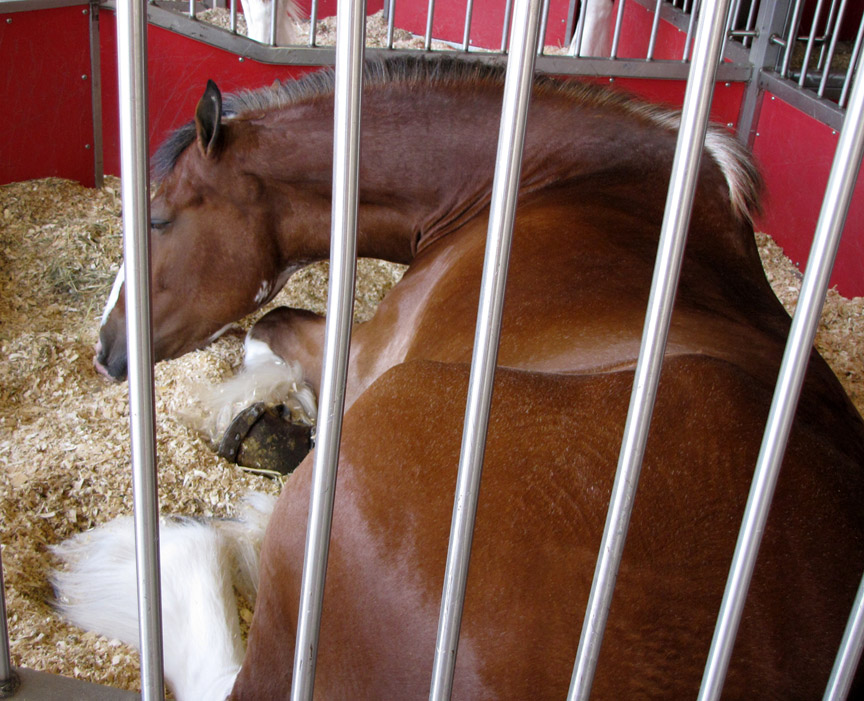
Clydesdales may be of several possible colors, including various shades of bay
(sometimes called brown), chestnut (sometimes called sorrel) or black.
Clydesdales have a range of characteristic white markings which are generally
present regardless of body colour. The most distinctive are four white feet and
a blaze, most often a full blaze or large, white "bald face" marking which
extends to the lips and chin and may also extend to the eye region. White on the
legs sometimes does not extend much above the feather, but in many cases, when a
horse carries the sabino colouring pattern, it can extend up the greater part of
the leg and even merge with a white underbelly. The sabino gene can also be
expressed more dramatically, spreading white hairs from the belly up the horse's
sides creating an effect that is referred to in the draft breeds as roan. A
chestnut or bay horse with this sabino expression is typically referred to as a
"strawberry roan" and a black horse with the same pattern is called a "blue
roan" by many Clydesdale enthusiasts. In North America, "high white" markings
are favoured, and bay predominates. In Scotland, a large number of roan horses
are exhibited.
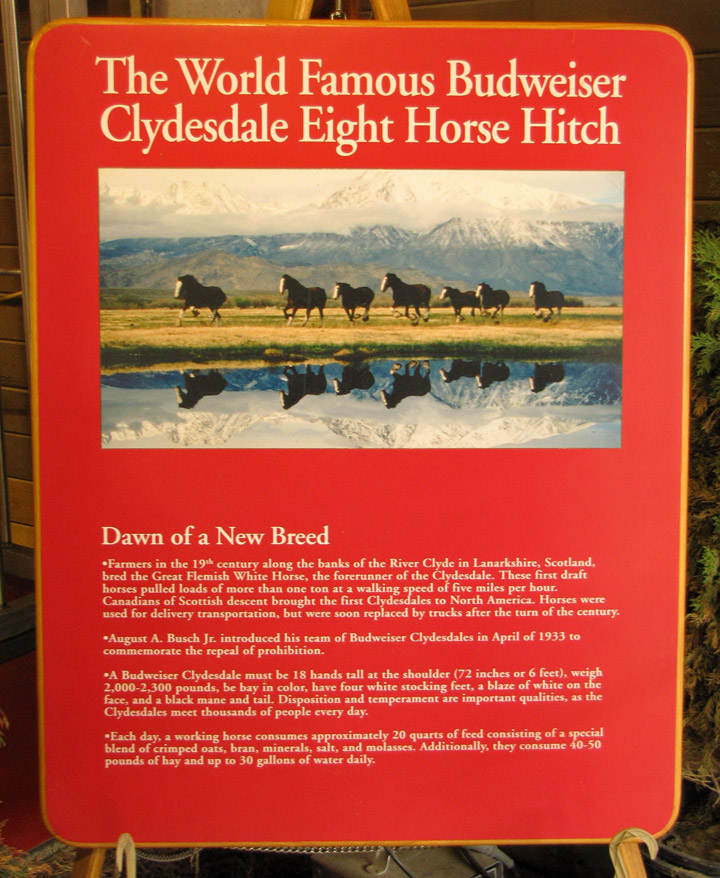
With the widespread inheritance of the sabino pattern, the feather tends to be
white, but can be black or chestnut, depending on the color of the leg markings
and the presence of markings. This trait developed as a result of native stock
and breeding with Flemish horses.
Drum horse of the Household Cavalry
On the other hand, Clydesdales can also have one or more dark legs, either mixed
with white hairs, or a solid shade of black or brownish-red. Hooves will match
the corresponding leg color, dark or light, at the point where the skin of the
leg meets the hoof wall, sometimes resulting in a striped or two-toned hoof.
Horses with white muzzles often have distinctive black spots around the lips and
chin.
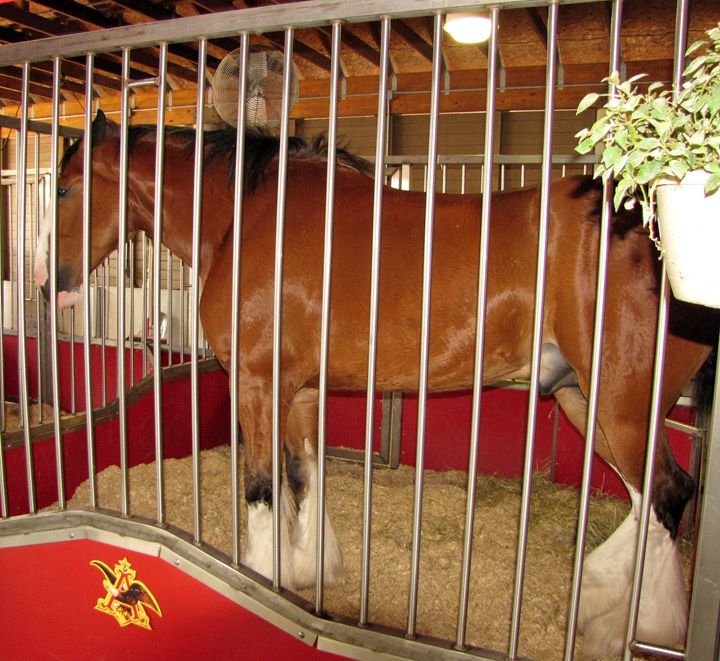
When Clydesdales were widely prevalent in Scotland, horses of skewbald and
piebald patterning were relatively common. These pinto colored animals
traditionally been used by the Household Cavalry (the mounted guard of the
reigning monarch of the United Kingdom), as drum horses to carry the 90 pound
silver kettle drums which accompany the band. A drum horse is typically a
piebald or skewbald horse with similar conformational characteristics to a
Clydesdale or a Shire horse.
In the United States and Ireland such brightly-colored horses are popular, and
the drum horse represents a scaled-up version of the "coloured cob" (often
mistaken as a "Gypsy Horse" or "Gypsy Vanner").
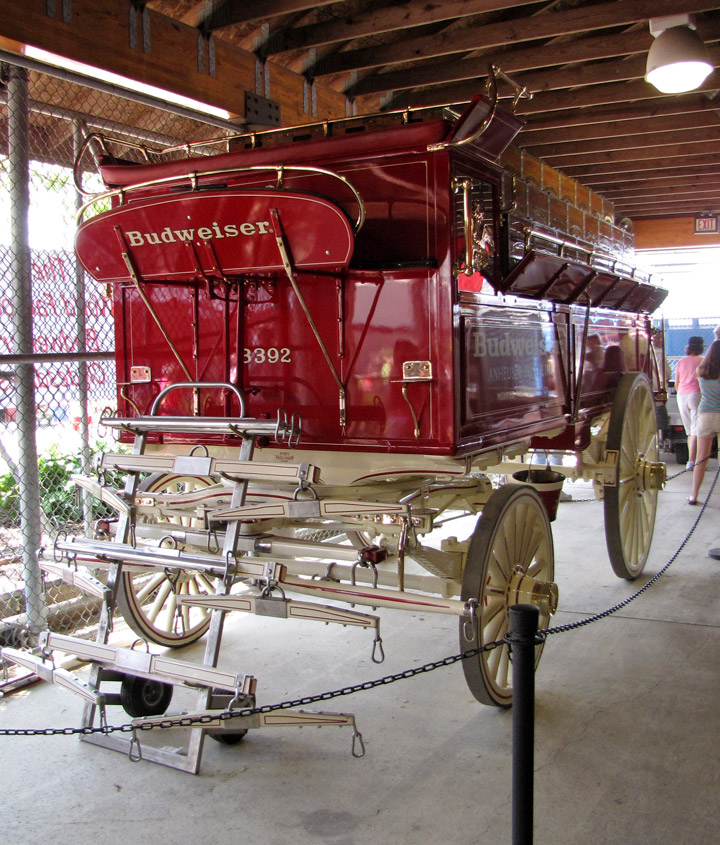
the wagon
Clydesdale foals, like all horses, are born after an 11-month pregnancy. At birth, they weigh up to 82 kilograms (180 pounds). They are fast growers and for the first few months gain up to 2 kilograms (4.4 pounds) per day; a Clydesdale mare needs to be capable of producing over 25 kilograms (55 pounds) of milk per day in order to support this rate of development.
The Clydesdale is thought to have arisen from the mid-18th century cross breeding of local mares with larger English and Flemish stock for use pulling farm equipment and carriages. They were further developed to meet the practical needs of early 19th century Scotland, where the robust constitution, somewhat shaggy coat, thick mane and feathered legs were suited to the climate.
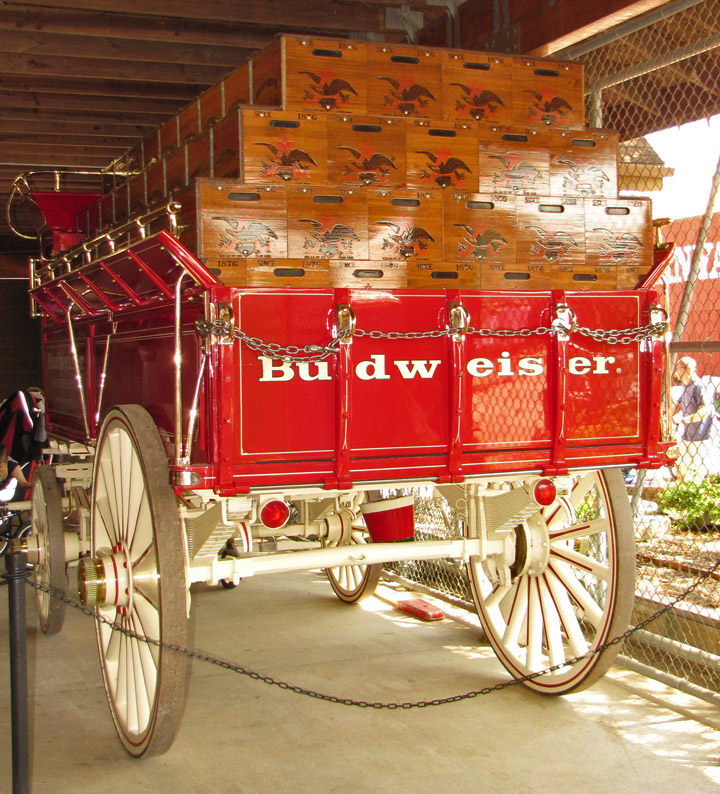
The breed was well received owing to its agile strength and docility, soon
spreading to northern England where it was used extensively to tow coal skips.
In the 19th century Clydesdales were exported to Australia, and New Zealand. In
Australia, with British Longhorn Cattle, they were an important draft animal.
The Longhorn is forgotten in Australia, but the Clydesdales have survived a
period of mid-twentieth century neglect to become regarded with the Merino sheep
as an icon of Australian rural industry. The Clydesdale is celebrated in one of
the most popular images of rural life, G.W.Lambert's painting "Across the Black
Soil Plains" which shows a team straining to pull a wagon loaded with the wool
clip which is "up to its axle-trees" in mud. Nowadays they are one of the most
popular exhibits at the agricultural shows and the Carlton and United Brewery
Clydesdales, which are stabled at the Sydney Showground are visited by many
thousands of people in conjunction with the Royal Easter Show each year. In New
Zealand, apart from general rural work, the Clydesdale was used extensively in
the timber industry, to pull from the forest the valuable logs of kauri pine,
highly prized for cabinet making.

Clydesdales were first shipped to North America in 1840, and later to South
America, Russia, Austria and Italy. Exports peaked in 1911 with a recorded 1,617
stallions trading hands. According to the Clydesdale Horse Society (formally
founded 1887), between 1884 and 1945 20,183 animals were exported. Two stallions
are recognized as the foundation of the breed: Lord Darney and Prince of Wales.
All Clydesdales horses today can be traced back to these two sires. The
development of the breed has come a long way from these two foundation sires.
There was a lot of focus on developing the hind leg and quality of hair.
As a beast of labor, Clydesdales had been largely replaced by tractors and other heavy machinery by the end of World War II. Through the determination of many small breeders the breed continued through the lean post World War II era. However, the horses are still used in situations where machines are unwanted or inferior, such as "eco-friendly" farming and logging operations. Clydesdales are now most often seen in competitive agricultural exhibitions such as state, county and national fairs.
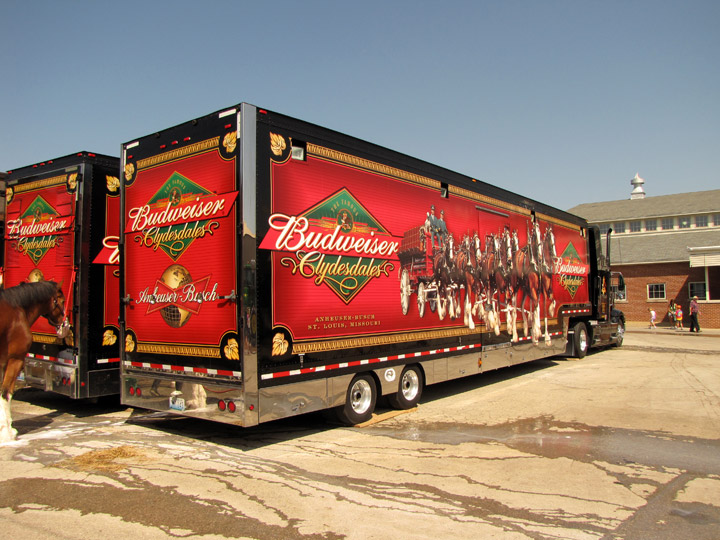
the air conditioned trucks to take them back to St. Louis
The Clydesdale became a symbol of the Anheuser-Busch beer company (makers of Budweiser) when August A. Busch II (Gussie Busch) told his father (then current President of Anheuser Busch) that he needed to come see the new Lincoln car he had purchased. After admonishing "Gussie" that purchasing a new luxury vehicle during the depression was unwise, he came out of the brewery in St. Louis and discovered to his delight a new Studebaker Beer Wagon and a perfectly conformed Six Horse Hitch of Clydesdales. Since that time, the Budweiser Clydesdales have appeared in many of their television commercials. Clydesdale hitches have had a long history as advertising and promotion tools of companies. The Wilson Packing Company and Hawthorn Melody Dairy are examples of companies in the past who actively campaigned Clydesdale hitches. The rise of company hitches helped to fuel the Clydesdale market during the post World War II era. Thus, color became a factor for breeders. The preference for the bay with four whites comes from this. The Budweiser Clydesdales make an annual appearance in the Tournament of Roses Parade in Pasadena, California by pulling the St. Louis, Missouri float.
Text from Wikipedia